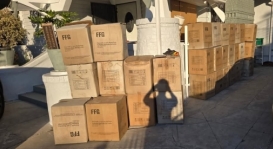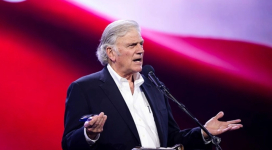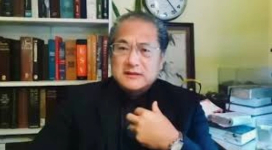New York -- Delegates from Christian communities around the world gathered at the Interchurch Center in New York City to commemorate the life and ministry of the Rev. Dr. Martin Luther King, Jan. 12. The worship service marked the first of many events planned as part of the 2004 World Council of Churches’ Decade to Overcome Violence focus on the U.S.
“We are gathered as peacemakers from various regions of the world to launch this year-long focus in the United States by lifting up the legacy of Martin Luther King Jr, whose work and ministry has inspired peacemakers around the globe,” said Rev. Leonid Kishkovsky, archpriest, Orthodox Church in America, and moderator, US Conference of the WCC, in opening remarks at the service.
“It is a contradiction of life to put peace ahead of justice,” said the Rev. Dr Otis Moss, the pastor of the Olivet Institutional Baptist Church in Cleveland, Ohio, in introductory remarks in his sermon. “There will be no international peace until there is international justice,” he said, quoting Israel’s first prime minister, David Ben Gurion.
Dr. Moss, a friend and associate of the Rev. Dr Martin Luther King Jr, reminded the delegates of the historical battles for peace and justice, specifically those fought for the civil rights of minorities in America.
“To forget is exile,” he said, “to remember is redemption.” Moss warned the congregation to never forget “the moans and groans of countless millions of human beings” who were imprisoned on slave ships and “who were fed to sharks if they died on passage, or served up to slave masters if they survived.”
Moss also cited redemptive historical developments during the past half-century, including the passage of the GI Bill in 1944, that opened educational and career opportunities to millions of disadvantaged veterans. In addition, he said that the establishment of the United Nations and the World Council of Churches were important international milestones on the way to universal peace and justice.
The national and international liberation movements, beginning with the independence of India in 1947, were redemptive signs, said Moss.
“When India gained independence, the British Empire had a nervous breakdown and the rest of western colonialism had a heart attack,” Moss said.
“What can we do to follow in Dr King’s footsteps?” Moss asked. “We must be about the business of building a new generation of prophets of justice,” he said. “We must be disciples of love, apostles of liberation, teachers of nonviolence, and ambassadors of reconciliation.”
Moss then called upon the gathered, as representatives of their faith communities, to commit themselves as God’s peacemakers.
Efforts to pursue peace must originate “in our commitment to break the bonds of injustice, and to bring justice and peace into our homes, and into our collective house - the White House,” Moss concluded. “When we break the bonds of injustice and oppression, then we become God’s peacemakers.”
Following Dr. Moss’ sermon, DOV coordinator Rev. Hansulrich Gerber presented the goals of the Decade to Overcome Violence through a multimedia presentation.
The following are the five main DOV goals:
· Addressing holistically the wide varieties of violence, both direct and structural, in homes, communities, and in international arenas and learning from the local and regional analyses of violence and ways to overcome violence.
· Challenging the churches to overcome the spirit, logic and practice of violence; to relinquish any theological justification of violence; and to affirm anew the spirituality of reconciliation and active nonviolence.
· Creating a new understanding of security in terms of cooperation and community, instead of in terms of domination and competition.
· Learning from the spirituality and resources for peace-building of other faiths to work with communities of other faiths in the pursuit of peace and to challenge the churches to reflect on the misuse of religious and ethnic identities in pluralistic societies.
· Challenging the growing militarization of our world, especially the proliferation of small arms and light weapons.







